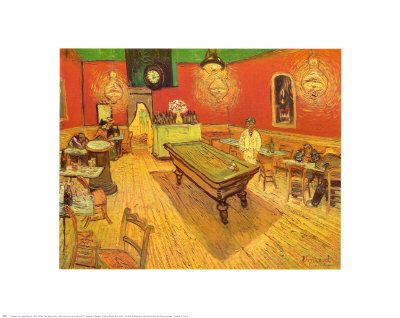
20% Discounts and FREE SHIPPING!

The Night Cafe Art Print
Vincent Van Gogh
The Truth About Van Gogh's The Night Cafe by Ace Toscano
While shooting the breeze in a local pool hall, I recently caught wind of a fiction currently circulating regarding Van Gogh's painting The Night Café (The Night Cafe in the Place Lamartine in Arles, 1888), a painting popular with pool players because its composition includes a rendering of a pool table. Obviously the creation of some student of inebriation who figured the turbulent life of Vincent Van Gogh wanted embellishment, this fiction began "Van Gogh had a brother who was a drunk and hung out in that bar."
I couldn't help myself and immediately interrupted the narrator and informed him that, based on that short intro, I already knew the story he had been told was not true. He didn't care, he said, because it was a good story and he liked the painting all the more because of it. And that's how the conversation ended--with his not asking me for my version and my not asking to hear more of his.
But, Van Gogh's one of my favorite painters. Having traveled far and wide to see his paintings first hand (In fact, several years back, my wife and I drove up to New Haven to see the actual painting now under discussion.) and having read many books dedicated to him and his art, I feel compelled to expose this particular story for what it is - pure bull shit.
Among my books is Letters of Vincent Van Gogh, edited by Mark Roskill, a compilation of Vincent's letters to his brother, Theo. Theo, by the way, was an art dealer who was dedicated to his brother and loved him as much as any man can love a brother. He believed in Vincent's artistic gifts and supported him financially for most of his adult life. Nowhere has it ever been noted or suggested that Theo was a drunk though Vincent's taste for absinthe is well documented.
As for the real story behind the painting of The Night Cafe, for it we will turn to an excerpt from the volume just mentioned, and get it in Vincent's own words:
Arles, September 8, 1888
My Dear Theo,
Thank you a thousand times for your kind letter and the 300 francs it contained; after some worrying weeks I have just had a much better one. And just as worries do not come singly, neither do the joys. For just because I am always bowed down under this difficulty of paying my landlords, I made up my mind to take it gaily. I swore at the said landlord, who after all isn't a bad fellow, and told him that to revenge myself for paying him so much money for nothing, I would paint the whole of his rotten shanty so as to repay myself. Then to the great joy of the landlord, of the postman whom I had already painted, of the visiting night prowlers, and of myself, for three nights running I sat up to paint and went to bed during the day. I often think that the night is more alive and more richly colored than the day. Now, as for getting back the money I have paid to the landlord by my painting, I do not dwell on that, for the picture (note: here he's writing about The Night Café) is one of the ugliest I have done. It is the equivalent, though different, of the "Potato Eaters."
I have tried to express the terrible passions of humanity by means of red and green.
The room is blood red and dark yellow with a green billiard table in the middle; there are four lemon-yellow lamps with a glow of orange and green. Everywhere there is a clash and contrast of the most alien reds and greens, in the figures of the sleeping hooligans, in the empty dreary room, in violet and blue. The blood-red and the yellow-green of the billiard table, for instance, contrast with the soft tender Louis XV green of the counter, on which there is a rose nosegay. The white clothes of the landlord, on vigil in a corner of this furnace, turn yellow, or pale luminous green.
I am making a drawing of it with the tones in watercolor to send to you tomorrow, to give you some idea of it…
The "Night Café" carries on from the "Sower," and so also do the head of the old peasant and of the poet, if I manage to do this latter picture.
It is color not locally true from the point of view of the realist, but color to suggest some emotion of an ardent temperament…
Many thanks then, and a good handshake, till tomorrow.
Yours,
Vincent
Sorry, if that's not as exciting as the story you might have heard. But, those are the facts.
For those of you who would like to read more about Vincent Van Gogh, you might enjoy two books by Irving Stone, Lust for Life and Dear Theo, as well as the collection of letters edited by Mark Roskill mentioned above. This latter contains a memoir written by Vincent's sister-in-law, Theo's wife.
Books On Van Gogh

© Copyright 2003- by Ace Toscano. All rights reserved.

